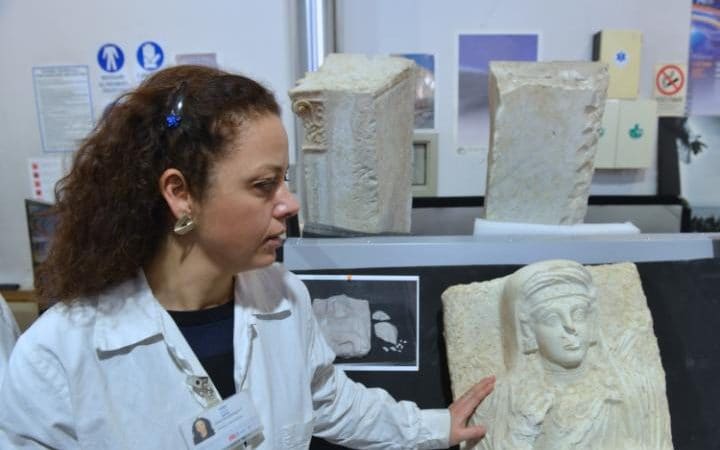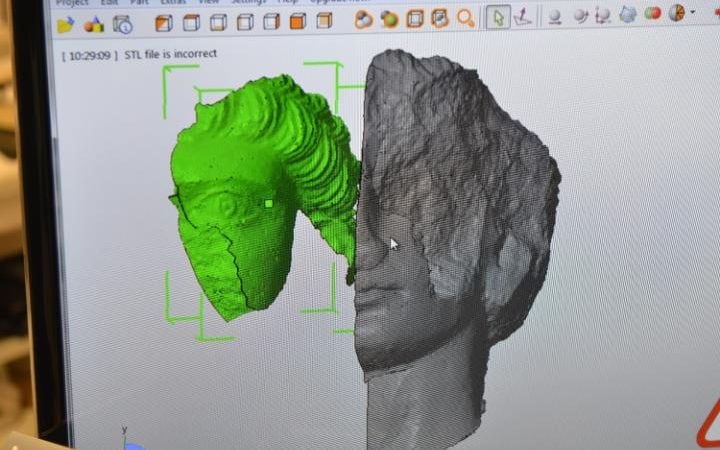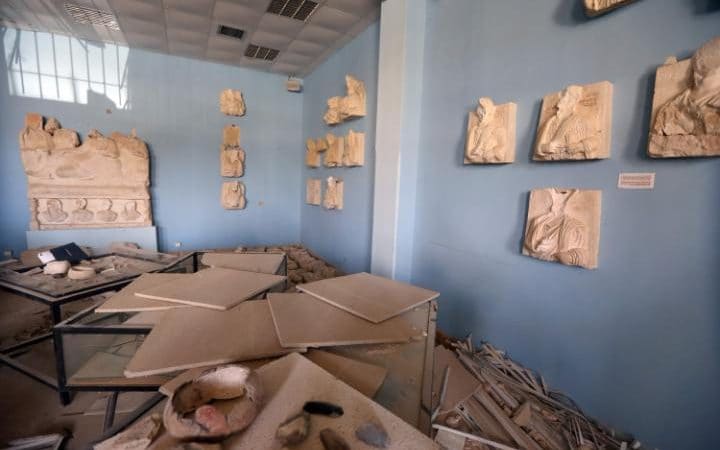While many of those rescued artifacts had been damaged, they’ve been able to be at least partially restored in many cases, both digitally and physically, with 3D technology. Among those items were a pair of funerary busts from the second century – one depicting a man, the other a woman, whom historians believe were part of a local family of wealthy merchants. Salvaged from Palmyra’s museum after the site was retaken by Russian and Syrian forces, the damaged artifacts were taken to Beirut and then to Rome, where a team of experts from the Institute for Conservation and Restoration (ICR) have been working for the past two months to make them whole again.
Technicians scanned the two busts with laser scanners and then replaced the missing pieces with 3D printed replicas. The male figure was especially badly damaged, with about half of its face missing, so the technicians created a “prosthetic” replacement for the missing half. The prosthetic was attached to the remainder of the bust with six small magnets, making it easily removable in case the missing piece is ever found.
“The resin prosthetics were coated with a very fine layer of stone dust to make them blend in with the original stone,” said Gisella Capponi, director of ICR. “It was a great honour for us to be able to restore such extraordinary artefacts, which were so brutally damaged by Isis.”

Khaled al-Asaad in 2002, in front of a first-century sarcophagus from Palmyra. [Image: Marc Deville/Gamma-Rapho via Getty Images]
The appearance of the man and woman depicted on the busts reveals the wealthy history of Palmyra; the man wears a Roman-style toga and the woman is wearing jewels around her neck and in her turban.

Daria Montemaggiori, a member of the restoration team, with the female bust. [Image: Chris Warde-Jones/The Telegraph]
“It was a very important trading town. A range of valuable things were traded through it, including ostriches, slaves, olive oil and precious stones and textiles,” said Frances Pinnock, a professor of ancient Near East archaeology at La Sapienza University in Rome. “It was part of the Roman Empire but then rebelled against Rome. This couple represent the elite of Palmyra, who were mostly rich merchants.”

3D scans were used to create a replacement “prosthetic” for the male figure. [Image: Chris Warde-Jones/The Telegraph]
Recently released drone footage of Palmyra shows further devastation. The façade of the Roman-era theatre has been severely damaged, and the sixteen columns of the Tetrapylon monument have been reduced to two. Still, the efforts of ICR and other organizations working to restore damaged artifacts from Syria and other conflict zones represent hope that what was destroyed can be rebuilt, and that Syria will once again, one day, be a place of peace whose art, history and people can safely return. Discuss in the Palmyra forum at 3DPB.com.
[Source: The Telegraph]
Subscribe to Our Email Newsletter
Stay up-to-date on all the latest news from the 3D printing industry and receive information and offers from third party vendors.
You May Also Like
Profiling a Construction 3D Printing Pioneer: US Army Corps of Engineers’ Megan Kreiger
The world of construction 3D printing is still so new that the true experts can probably be counted on two hands. Among them is Megan Kreiger, Portfolio Manager of Additive...
US Army Corps of Engineers Taps Lincoln Electric & Eaton for Largest 3D Printed US Civil Works Part
The Soo Locks sit on the US-Canadian border, enabling maritime travel between Lake Superior and Lake Huron, from which ships can reach the rest of the Great Lakes. Crafts carrying...
Construction 3D Printing CEO Reflects on Being Female in Construction
Natalie Wadley, CEO of ChangeMaker3D, could hear the words of her daughter sitting next to her resounding in her head. “Mum, MUM, you’ve won!” Wadley had just won the prestigious...
1Print to Commercialize 3D Printed Coastal Resilience Solutions
1Print, a company that specializes in deploying additive construction (AC) for infrastructure projects, has entered an agreement with the University of Miami (UM) to accelerate commercialization of the SEAHIVE shoreline...































